Modification of the Adsorption Capacity of Brick Industry Fly Ash for the Removal of Cd(II)
Abstract
1. Introduction
2. Materials and Methods
2.1. Sample
2.2. Instruments
2.3. Experimental Procedure
2.3.1. Coal Ash Treatment
2.3.2. Chemical Modification of Fly Ash
- According to the selected experimental design, 25 g of fly ashes are weighed and introduced in beakers, then 100 mL NaOH of concentrations 1.5 M; 2.0 M, and 2.5 M respectively are incorporated, being the ash-to-alkaline solution ratio of 25% w/v.
- The contents of the mixture in the beakers are poured into Teflon bottles (250 mL capacity), to be shaken at a speed of 500 rpm for 30, 60, and 90 min. Then they are taken to the oven for treatment in the thermal medium for 24 h at 100 °C.
- Next, the modified fly ash samples are washed to a final pH of 10, filtered, and dried at 110 °C for 8 h. After drying, the product is subjected to the milling process, and finally, representative samples are taken to determine the mineralogical composition and surface area.
- The initial fly ash was only sieved and washed to a pH of 9; a portion of this ash was used for the alkaline treatment, resulting in modified fly ash, whose final washing pH value was 10. In the treatment process, the initial pH of the Cd(II) solution was 5.44; upon adding the fly ash, the final solution reached an average equilibrium pH of 7.61.
2.3.3. Evaluation of the Removal Capacity of the Modified Fly Ash
- Notably, 0.5 g of modified fly ash is incorporated in 250 mL capacity beakers, and then 200 mL of synthetic Cd(II) ion solution of 110 ppm concentration is added, the ratio of the mass of modified fly ash to the volume of solution is 1:400.
- The beakers containing the sample and solution are placed onto the electric hot plate, after which a magnetic stir bar is added. The stirring speed is adjusted according to the specifications of the experimental design, and the reaction time is carefully monitored to ensure accurate results.
- The removal tests are carried out at pH 5.44 corresponding to the Cd(II) ion solution and at room temperature.
- After the removal process, it is filtered with Whatman filter paper Cat. No. 1001150, and the remaining solution is received in special flasks to determine its composition by ICP-OES plasma spectroscopy.
2.4. Data Procedure
3. Results
3.1. Characterization of Fly Ashes
3.1.1. Mineralogical Composition and Diffractogram
3.1.2. Surface Area
3.2. Characterization of Modified Fly Ashes
3.2.1. Mineralogical Composition
3.2.2. Surface Area Modification
3.2.3. Diffractogram
3.3. Regarding the Influence of NaOH Concentration and Stirring Time
3.3.1. Analysis of Variance for the Increase in Surface Area
- NaOH concentration has a negative effect of −3.42% on the increase in surface area.
- Stirring time has a positive effect of 2.28%, indicating a favorable influence on surface area.
- The interaction of NaOH concentration with NaOH concentration exhibits a negative effect of −13.48%, highlighting a diminishing return when this variable is squared.
- The interaction of NaOH concentration by stirring time results in a negative effect of −2.30%, suggesting a small antagonistic interaction between these factors.
- The interaction of stirring time with stirring time has the most significant negative effect of −25.38%, reflecting diminishing returns when stirring time is excessively increased.
3.3.2. Regression Coefficients for Surface Area Increase
3.3.3. Response Surface for the Increase of Surface Area
3.3.4. Contour Plot for the Surface Area Increase
3.3.5. Analysis of the Influence of Concentration and Stirring Time
- The NaOH concentration variable does not exhibit a minimum value for the surface area, indicating a consistent influence across its range.
- In contrast, the stirring time variable reaches a minimum value of 30 min for the surface area before contributing positively, reflecting a less consistent influence.
3.4. Regarding the Removal of Cd(II) Ions
3.5. Regarding the Influence of Time and Stirring Speed
3.5.1. Analysis of Variance for the Removal Percentage
3.5.2. Regression Coefficients for the Removal Percentage
3.5.3. Response Surface for the Removal Percentage
3.5.4. Contour Plot for the Percentage of Removal
3.5.5. Analysis of the Influence of Stirring Time and Stirring Speed
4. Discussion
5. Conclusions
Author Contributions
Funding
Data Availability Statement
Acknowledgments
Conflicts of Interest
References
- Valeev, D.; Kunilova, I.; Alpatov, A.; Mikhailova, A.; Goldberg, M.; Kondratiev, A. Complex Utilisation of Ekibastuz Brown Coal Fly Ash: Iron & Carbon Separation and Aluminum Extraction. J. Clean. Prod. 2019, 218, 192–201. [Google Scholar] [CrossRef]
- Gjyli, S.; Korpa, A.; Teneqja, V.; Siliqi, D.; Belviso, C. Siliceous Fly Ash Utilization Conditions for Zeolite Synthesis. Environ. Sci. Proc. 2021, 6, 24. [Google Scholar] [CrossRef]
- Alterary, S.; Marei, N.H. The Impact of Coal Fly Ash Purification on Its Antibacterial Activity. Minerals 2020, 10, 1002. [Google Scholar] [CrossRef]
- Fukasawa, T.; Horigome, A.; Tsu, T.; Karisma, A.D.; Maeda, N.; Huang, A.N.; Fukui, K. Utilization of Incineration Fly Ash from Biomass Power Plants for Zeolite Synthesis from Coal Fly Ash by Hydrothermal Treatment. Fuel Process. Technol. 2017, 167, 92–98. [Google Scholar] [CrossRef]
- UNE-EN 450-1:2006+A1:2008; Cenizas Volantes Para Hormigón. Parte 1: Definiciones, Especificaciones y Criterios de Conformidad. Asociación Española de Normalización y Certificación: Madrid, Spain, 2008.
- Bhatt, A.; Priyadarshini, S.; Acharath Mohanakrishnan, A.; Abri, A.; Sattler, M.; Techapaphawit, S. Physical, Chemical, and Geotechnical Properties of Coal Fly Ash: A Global Review. Case Stud. Constr. Mater. 2019, 11, e00263. [Google Scholar] [CrossRef]
- Whiteside, M.; Herndon, J.M.; Syed Zaidi, F. Aerosolized Coal Fly Ash: Risk Factor for COPD and Respiratory Disease. J. Adv. Med. Med. Res. 2018, 26, 1–13. [Google Scholar] [CrossRef]
- Yadav, V.K.; Saxena, P.; Lal, C.; Gnanamoorthy, G.; Choudhary, N.; Singh, B.; Tavker, N.; Kalasariya, H.; Kumar, P. Synthesis and Characterization of Mullites From Silicoaluminous Fly Ash Waste. Int. J. Appl. Nanotechnol. Res. (IJANR) 2020, 5, 10–25. [Google Scholar] [CrossRef]
- Ge, J.C.; Yoon, S.K.; Choi, N.J. Application of Fly Ash as an Adsorbent for Removal of Air and Water Pollutants. Appl. Sci. 2018, 8, 1116. [Google Scholar] [CrossRef]
- Carreño-Flórez, E.F.; Ferrer-Pacheco, M.Y.; Peña-Rodríguez, G. Sodic and Potassium Zeolites from Fly Ash Coming from Coal Combustion of Thermoelectric Termotasajero S.A.S. Cienc. Desarro. 2019, 10, 219–233. [Google Scholar] [CrossRef]
- Miricioiu, M.G.; Niculescu, V.C. Fly Ash, from Recycling to Potential Raw Material for Mesoporous Silica Synthesis. Nanomaterials 2020, 10, 474. [Google Scholar] [CrossRef]
- Feng, W.; Wan, Z.; Daniels, J.; Li, Z.; Xiao, G.; Yu, J.; Xu, D.; Guo, H.; Zhang, D.; May, E.F.; et al. Synthesis of High Quality Zeolites from Coal Fly Ash: Mobility of Hazardous Elements and Environmental Applications. J. Clean. Prod. 2018, 202, 390–400. [Google Scholar] [CrossRef]
- García Barrero, J.A.; Pazos Zarama, M.C.; Chaparro Barajas, J.R.; Fonseca Martínez, D.A.; Pavón González, E.; Alba Carranza, M.D. Síntesis De Zβ A Partir de Cenizas Volantes, Utilizadas En Liberación Controlada De Nitratos. Cienc. Desarro. 2020, 11, 159–175. [Google Scholar] [CrossRef]
- Iqbal, A.; Sattar, H.; Haider, R.; Munir, S. Synthesis and Characterization of Pure Phase Zeolite 4A from Coal Fly Ash. J. Clean. Prod. 2019, 219, 258–267. [Google Scholar] [CrossRef]
- Wulandari, W.; Paramitha, T.; Rizkiana, J.; Sasongko, D. Characterization of Zeolite A from Coal Fly Ash Via Fusion-Hydrothermal Synthesis Method. IOP Conf. Ser. Mater. Sci. Eng. 2019, 543, 012034. [Google Scholar] [CrossRef]
- Parra-Huertas, R.A.; Calderón-Carvajal, C.O.; Gómez-Cuaspud, J.A.; Vera-López, E. Synthesis and Characterization of Faujasite-Na from Fly Ash by the Fusion-Hydrothermal Method. Boletín Soc. Española Cerámica Vidr. 2023, 62, 527–542. [Google Scholar] [CrossRef]
- Amoni, B.C.; Freitas, A.D.L.; Bessa, R.A.; Oliveira, C.P.; Bastos-Neto, M.; Azevedo, D.C.S.; Lucena, S.M.P.; Sasaki, J.M.; Soares, J.B.; Soares, S.A.; et al. Effect of Coal Fly Ash Treatments on Synthesis of High-Quality Zeolite A as a Potential Additive for Warm Mix Asphalt. Mater. Chem. Phys. 2022, 275, 125197. [Google Scholar] [CrossRef]
- Längauer, D.; Čablík, V.; Hredzák, S.; Zubrik, A.; Matik, M.; Danková, Z. Preparation of Synthetic Zeolites from Coal Fly Ash by Hydrothermal Synthesis. Materials 2021, 14, 1267. [Google Scholar] [CrossRef]
- Makgabutlane, B.; Nthunya, L.N.; Musyoka, N.; Dladla, B.S.; Nxumalo, E.N.; Mhlanga, S.D. Microwave-Assisted Synthesis of Coal Fly Ash-Based Zeolites for Removal of Ammonium from Urine. RSC Adv. 2020, 10, 2416–2427. [Google Scholar] [CrossRef]
- Boycheva, S.; Zgureva, D.; Lazarova, K.; Babeva, T.; Popov, C.; Lazarova, H.; Popova, M. Progress in the Utilization of Coal Fly Ash by Conversion to Zeolites with Green Energy Applications. Materials 2020, 13, 2014. [Google Scholar] [CrossRef]
- Joseph, I.V.; Tosheva, L.; Doyle, A.M. Simultaneous Removal of Cd(II), Co(II), Cu(II), Pb(II), and Zn(II) Ions from Aqueous Solutions via Adsorption on FAU-Type Zeolites Prepared from Coal Fly Ash. J. Environ. Chem. Eng. 2020, 8, 103895. [Google Scholar] [CrossRef]
- He, X.; Yao, B.; Xia, Y.; Huang, H.; Gan, Y.; Zhang, W. Coal Fly Ash Derived Zeolite for Highly Efficient Removal of Ni2+ Inwaste Water. Powder Technol. 2020, 367, 40–46. [Google Scholar] [CrossRef]
- Yang, L.; Qian, X.; Yuan, P.; Bai, H.; Miki, T.; Men, F.; Li, H.; Nagasaka, T. Green Synthesis of Zeolite 4A Using Fly Ash Fused with Synergism of NaOH and Na2CO3. J. Clean. Prod. 2019, 212, 250–260. [Google Scholar] [CrossRef]
- Liu, Y.; Wang, G.; Wang, L.; Li, X.; Luo, Q.; Na, P. Zeolite P Synthesis Based on Fly Ash and Its Removal of Cu(II) and Ni(II) Ions. Chin. J. Chem. Eng. 2019, 27, 341–348. [Google Scholar] [CrossRef]
- Ren, X.; Xiao, L.; Qu, R.; Liu, S.; Ye, D.; Song, H.; Wu, W.; Zheng, C.; Wu, X.; Gao, X. Synthesis and Characterization of a Single Phase Zeolite A Using Coal Fly Ash. RSC Adv. 2018, 8, 42200–42209. [Google Scholar] [CrossRef]
- Tauanov, Z.; Shah, D.; Inglezakis, V.; Jamwal, P.K. Hydrothermal Synthesis of Zeolite Production from Coal Fly Ash: A Heuristic Approach and Its Optimization for System Identification of Conversion. J. Clean. Prod. 2018, 182, 616–623. [Google Scholar] [CrossRef]
- Sivalingam, S.; Sen, S. Optimization of Synthesis Parameters and Characterization of Coal Fly Ash Derived Microporous Zeolite X. Appl. Surf. Sci. 2018, 455, 903–910. [Google Scholar] [CrossRef]
- Kunecki, P.; Panek, R.; Wdowin, M.; Franus, W. Synthesis of Faujasite (FAU) and Tschernichite (LTA) Type Zeolites as a Potential Direction of the Development of Lime Class C Fly Ash. Int. J. Miner. Process. 2017, 166, 69–78. [Google Scholar] [CrossRef]
- Liu, J.; Mwamulima, T.; Wang, Y.; Fang, Y.; Song, S.; Peng, C. Removal of Pb(II) and Cr(VI) from Aqueous Solutions Using the Fly Ash-Based Adsorbent Material-Supported Zero-Valent Iron. J. Mol. Liq. 2017, 243, 205–211. [Google Scholar] [CrossRef]
- Xiyili, H.; Çetintaş, S.; Bingöl, D. Removal of Some Heavy Metals onto Mechanically Activated Fly Ash: Modeling Approach for Optimization, Isotherms, Kinetics and Thermodynamics. Process Saf. Environ. Prot. 2017, 109, 288–300. [Google Scholar] [CrossRef]
- Cardoso, A.M.; Horn, M.B.; Ferret, L.S.; Azevedo, C.M.N.; Pires, M. Integrated Synthesis of Zeolites 4A and Na–P1 Using Coal Fly Ash for Application in the Formulation of Detergents and Swine Wastewater Treatment. J. Hazard. Mater. 2015, 287, 69–77. [Google Scholar] [CrossRef]
- Abbas, S.; Saleem, M.A.; Kazmi, S.M.S.; Munir, M.J. Production of Sustainable Clay Bricks Using Waste Fly Ash: Mechanical and Durability Properties. J. Build. Eng. 2017, 14, 7–14. [Google Scholar] [CrossRef]
- Ortiz Medina, Ó.L.; Agudelo Valencia, R.N.; Tovar Castañeda, L.M.; Gutiérrez Camargo, N. Evaluación de Cenizas Volantes Como Material Adsorbente Para La Remoción de Pb2+ En Solución Acuosa. Revista Mutis 2018, 8, 47–56. [Google Scholar] [CrossRef]
- Pérez-Chauca, L.F. Condiciones de Operación Favorables Para La Modificación Del Área Superficial de Las Cenizas Volantes de La Industria Del Cocido de Ladrillos Para Su Aplicación En La Remoción de Iones Cadmio (II); Universidad Nacional Federico Villarreal: Lima, Peru, 2023. [Google Scholar]
- Amaya, J.; Tristancho, A.; Sánchez Castellanos, F.J. Employing Fly Ash and FCC Catalyser Waste in Recovering Chrome (III) from Liquid Effluent Emitted by Tanneries. Rev. Ing. Investig. 2005, 57, 39–48. [Google Scholar]
- González, D.R.; Pérez, L.; Santa, A.; Ramírez, J.H. Producción y Caracterización de Zeolita Obtenida a Partir de Ceniza Volante Mediante DRX. Momento Rev. Física 2014, 48E, 52–60. [Google Scholar]

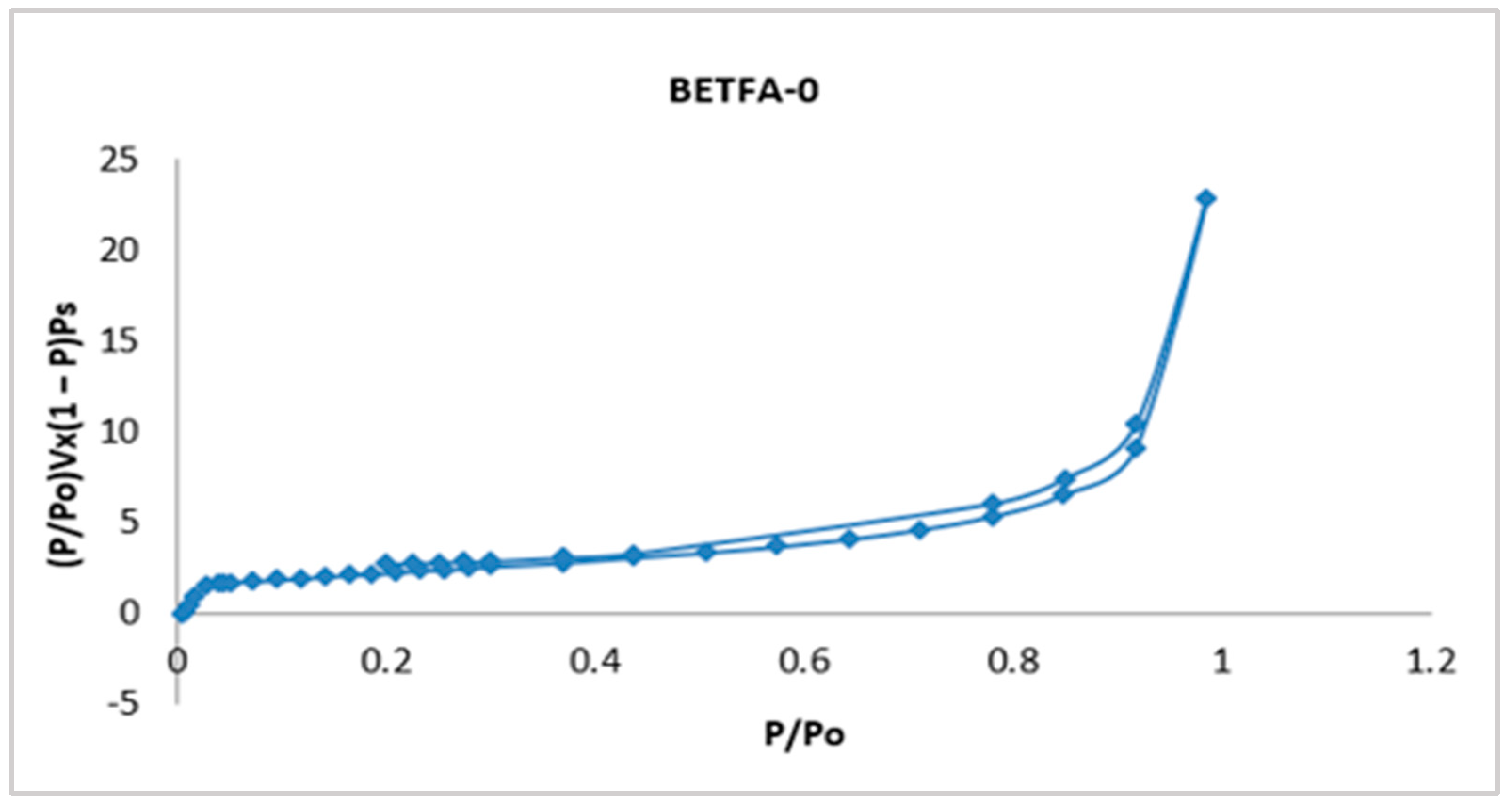


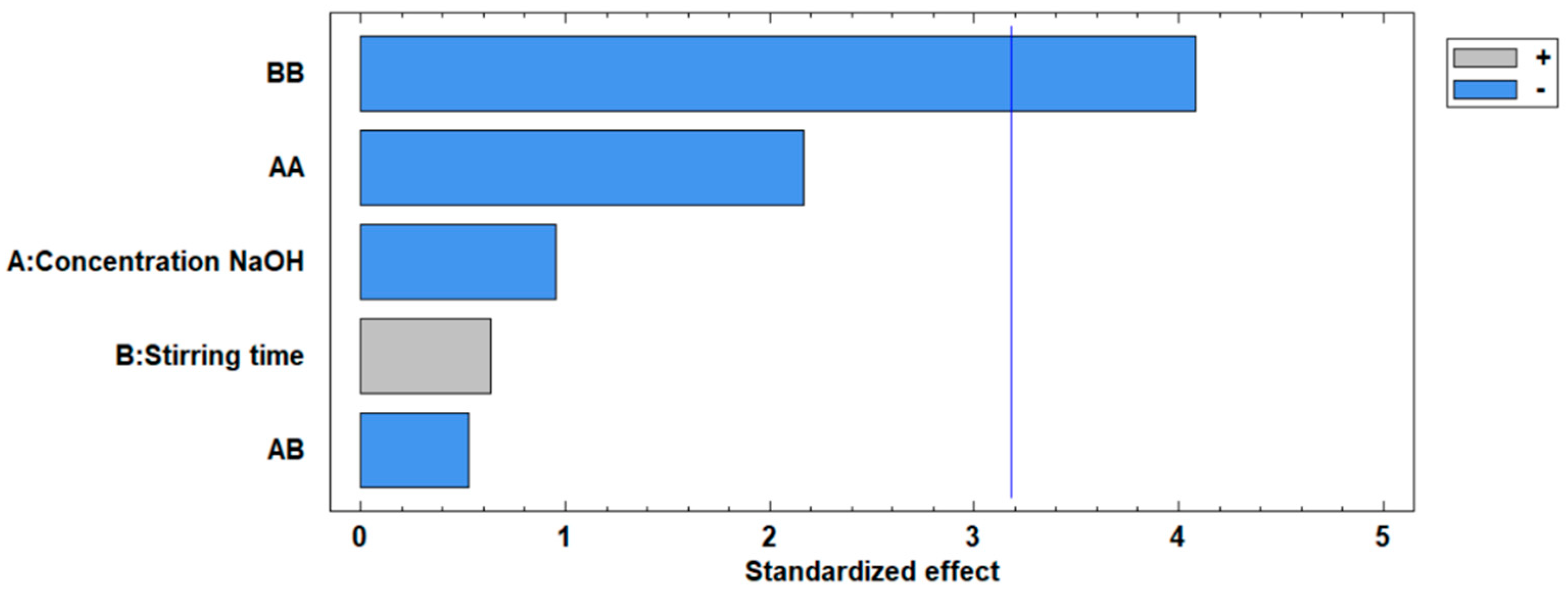

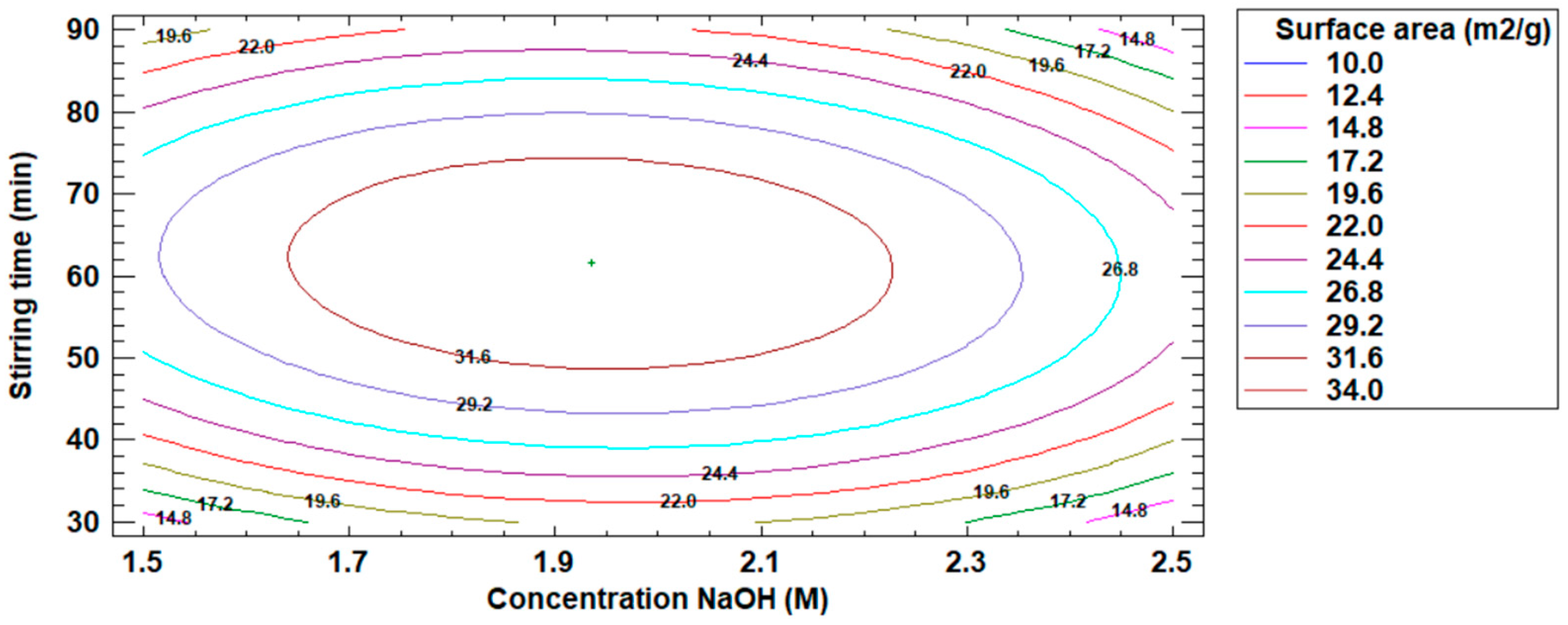
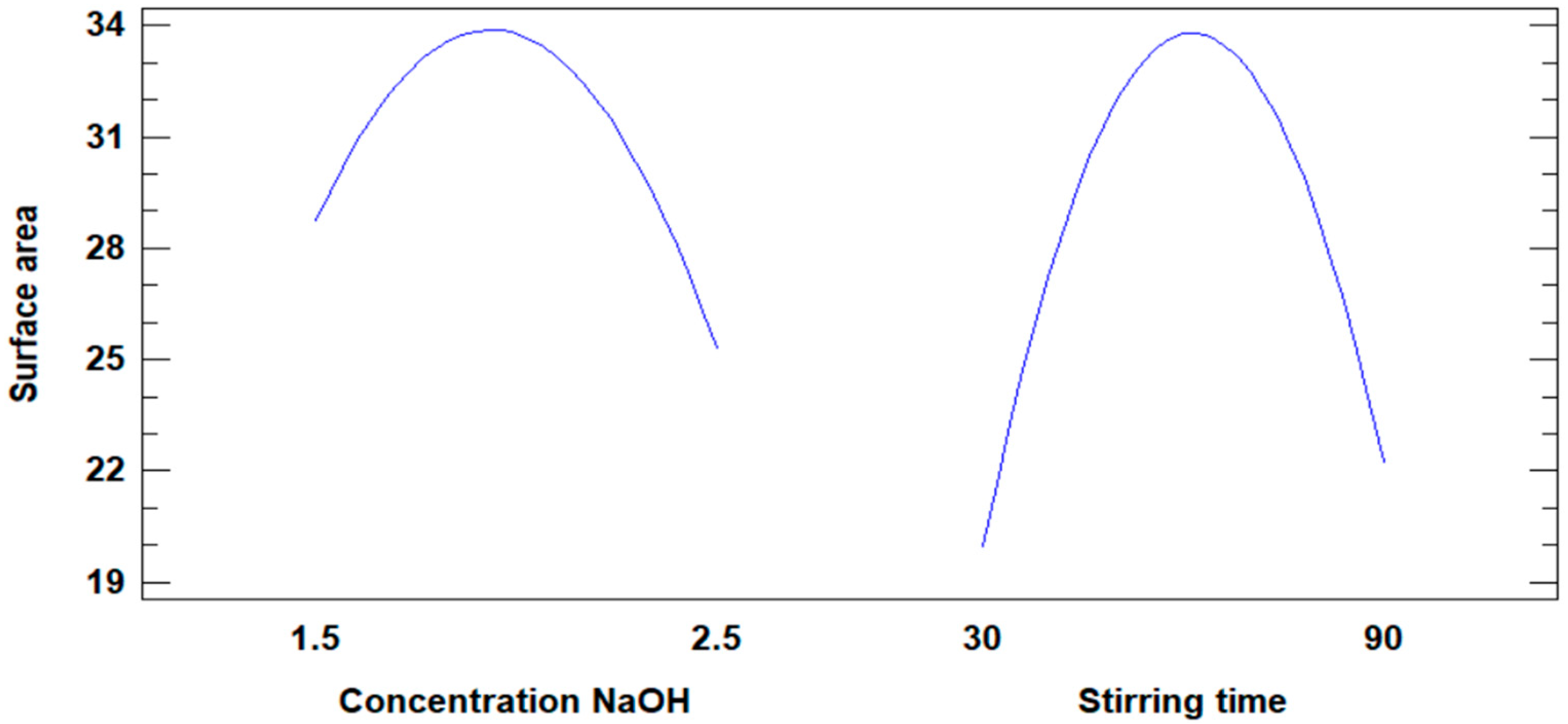
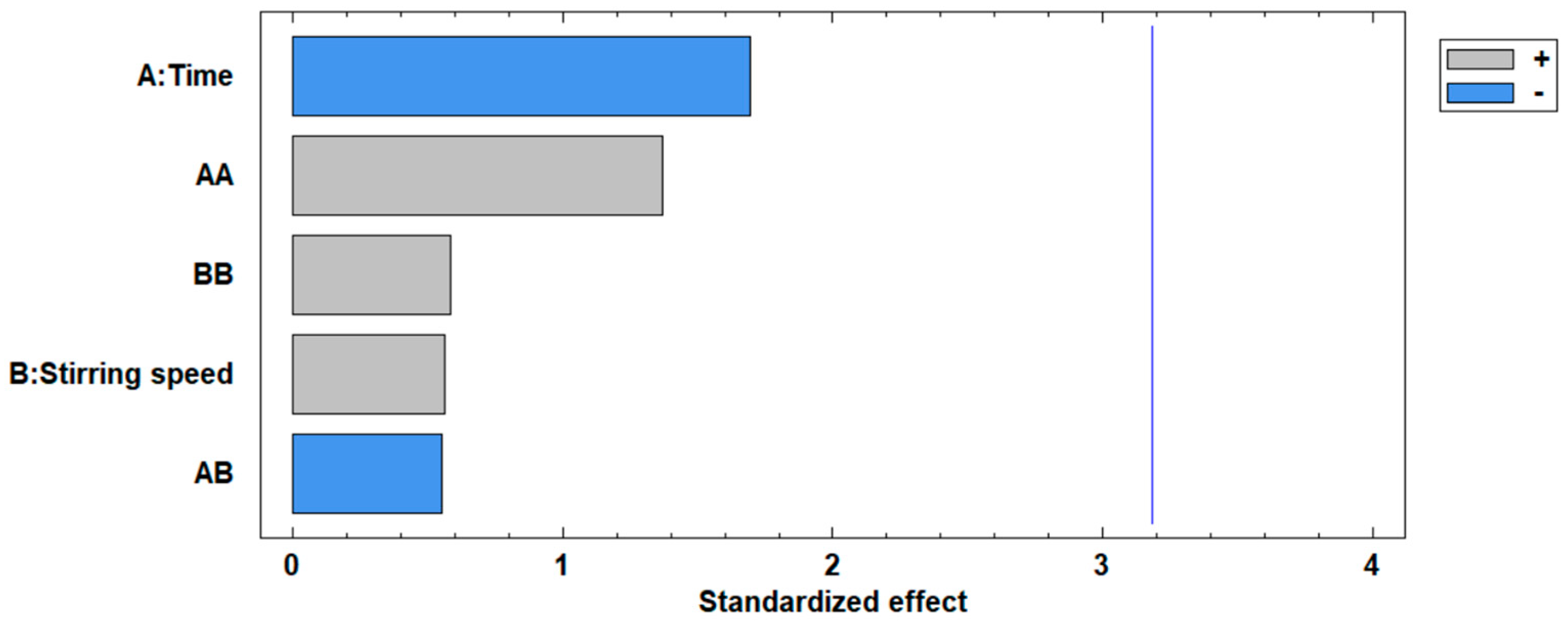
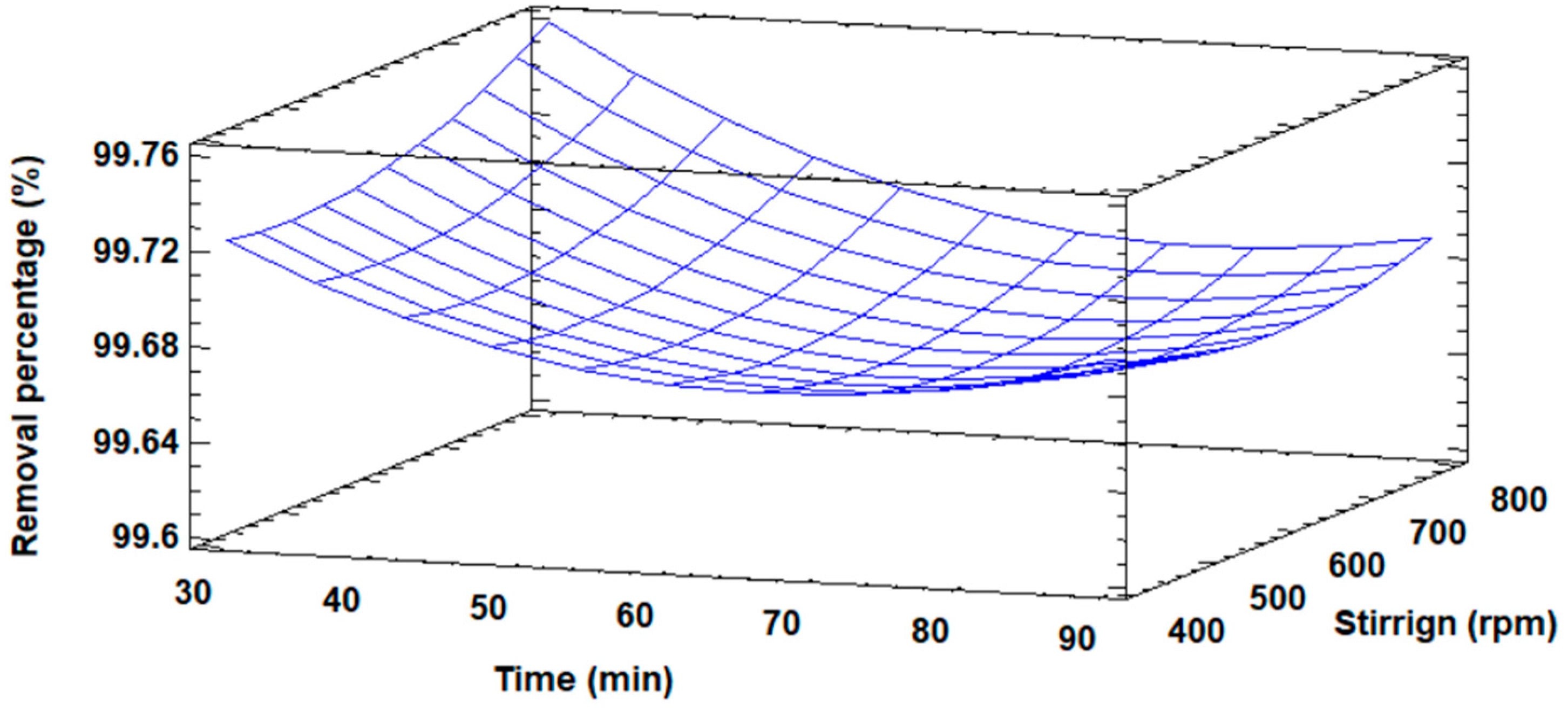
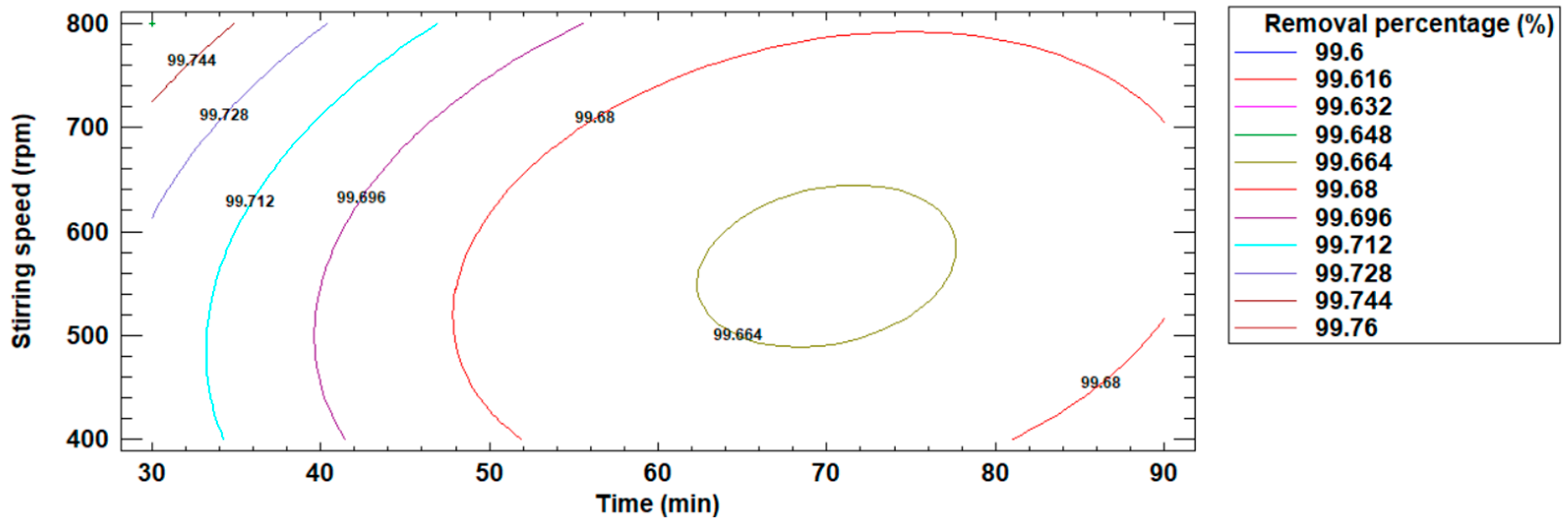
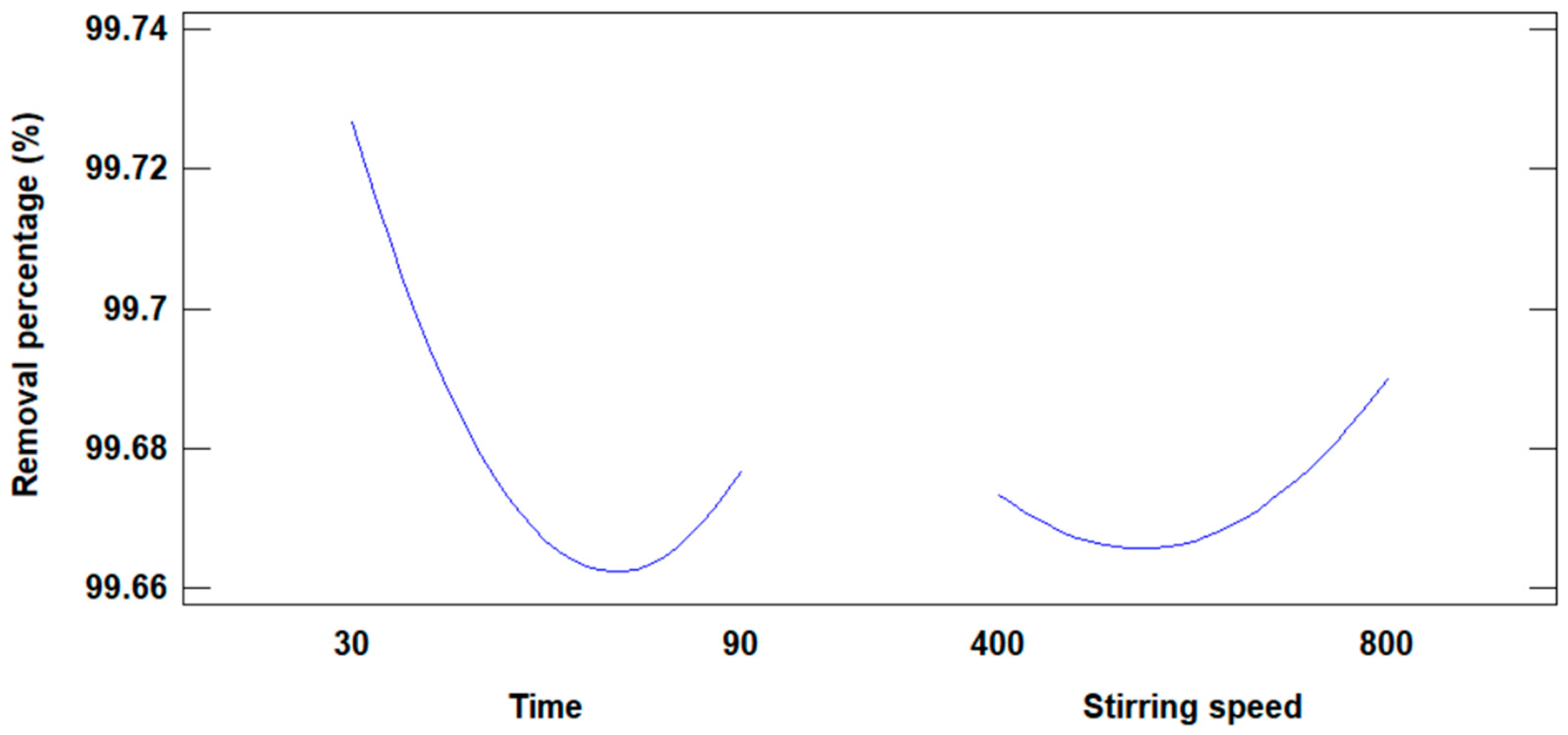
| Test | Sample | Stirring Time (min) | Stirring Speed (rpm) |
|---|---|---|---|
| 1 | RCd-0-30-400 | 30 | 400 |
| 2 | RCd-0-60-600 | 60 | 600 |
| 3 | RCd-0-90-800 | 90 | 800 |
| Test | Sample | NaOH Concentration (M) | Stirring Time (min) |
|---|---|---|---|
| 1 | MFA-1 | 2.5 | 30 |
| 2 | MFA-2 | 1.5 | 30 |
| 3 | MFA-3 | 1.5 | 90 |
| 4 | MFA-4 | 1.5 | 60 |
| 5 | MFA-5 | 2.5 | 90 |
| 6 | MFA-6 | 2.5 | 60 |
| 7 | MFA-7 | 2.0 | 60 |
| 8 | MFA-8 | 2.0 | 30 |
| 9 | MFA-9 | 2.0 | 90 |
| Test | Nomenclature | Time (min) | Stirring Speed (rpm) |
|---|---|---|---|
| 1 | RCd-1 | 30 | 400 |
| 2 | RCd-2 | 30 | 800 |
| 3 | RCd-3 | 60 | 800 |
| 4 | RCd-4 | 90 | 400 |
| 5 | RCd-5 | 90 | 800 |
| 6 | RCd-6 | 90 | 600 |
| 7 | RCd-7 | 60 | 600 |
| 8 | RCd-8 | 30 | 600 |
| 9 | RCd-9 | 60 | 400 |
| Sample | Time (min) | Speed (rpm) | [Cd2+]i ppm | [Cd2+]f ppm ± 0.01 | % Removal |
|---|---|---|---|---|---|
| RCd-0-30-400 | 30 | 400 | 110 | 93.8 | 14.73 |
| RCd-0-60-600 | 60 | 600 | 110 | 83.8 | 21.10 |
| RCd-0-90-800 | 90 | 800 | 110 | 83.4 | 24.18 |
| Average | 20.00 |
| Ash Component | % by Mass for Each Sample | |||||||||
|---|---|---|---|---|---|---|---|---|---|---|
| XRD-0 | XRD-1 | XRD-2 | XRD-3 | XRD-4 | XRD-5 | XRD-6 | XRD-7 | XRD-8 | XRD-9 | |
| Calcite | - | - | - | - | - | - | - | 1.82 | - | - |
| Quartz | 92.53 | 30.69 | 45.36 | 44.89 | 46.37 | 58.92 | 69.39 | 43.48 | 47.53 | 47.12 |
| Faujasite | - | - | - | - | 8.32 | - | - | - | - | - |
| Gismondine | - | 24.35 | 19.21 | 35.61 | 16.14 | 10.21 | 32.26 | 35.97 | - | |
| Muscovite | 7.47 | 4.23 | 4.01 | 6.03 | 4.88 | 18.45 | 12.24 | 4.21 | 4.51 | 1.92 |
| Sodalite | - | 32.79 | 31.42 | - | 40.43 | - | - | - | - | 50.96 |
| Zeolite | - | 7.94 | - | 13.47 | - | 6.49 | 8.16 | 18.23 | 11.99 | - |
| No. Minerals | 2 | 5 | 4 | 4 | 4 | 4 | 4 | 5 | 4 | 3 |
| Modified Fly Ash | NaOH Concentration (M) | Time (min) | Surface Area (m2/g) |
|---|---|---|---|
| BETMFA-1 | 2.5 | 30 | 13.75 |
| BETMFA-2 | 1.5 | 30 | 10.89 |
| BETMFA-3 | 1.5 | 90 | 17.35 |
| BETMFA-4 | 1.5 | 60 | 32.62 |
| BETMFA-5 | 2.5 | 90 | 15.60 |
| BETMFA-6 | 2.5 | 60 | 21.25 |
| BETMFA-7 | 2.0 | 60 | 33.99 |
| BETMFA-8 | 2.0 | 30 | 21.72 |
| BETMFA-9 | 2.0 | 90 | 20.25 |
| Source | Sum of Squares | Df | Mean Square | F-Ratio | p-Value |
|---|---|---|---|---|---|
| A: Concentration | 17.5446 | 1 | 17.5446 | 0.91 | 0.4112 |
| B: Time | 7.7976 | 1 | 7.7976 | 0.40 | 0.5706 |
| AA | 90.9451 | 1 | 90.9451 | 4.70 | 0.1187 |
| AB | 5.31303 | 1 | 5.31303 | 0.27 | 0.6365 |
| BB | 322.241 | 1 | 322.241 | 16.65 | 0.0266 |
| Total Error | 58.0459 | 3 | 19.3486 | ||
| Total (corr.) | 501.888 | 8 |
| Effect | Estimate | Standard Error |
|---|---|---|
| Average | 33.7822 | 3.2786 |
| A: Concentration | −3.42 | 3.59153 |
| B: Stirring Time | 2.28 | 3.59153 |
| AA | −13.4867 | 6.22071 |
| AB | −2.305 | 4.39871 |
| BB | −25.3867 | 6.22071 |
| Regression Coefficient | Estimate |
|---|---|
| Constant | −129.544 |
| A: Concentration | 109.083 |
| B: Stirring Time | 1.88411 |
| AA | −26.9733 |
| AB | −0.076833 |
| BB | −0.0141037 |
| Factor | Low | High | Optimum |
|---|---|---|---|
| Concentration (M) | 1.50 | 2.50 | 1.93 |
| Stirring time (min) | 30.0 | 90.0 | 61.52 |
| Sample | Time (min) | Stirring Speed (rpm) | [Cd2+]f (ppm) ± 0.01 | [Cd2+] Removal (%) |
|---|---|---|---|---|
| RCd-1 | 30 | 400 | 0.31 | 99.72 |
| RCd-2 | 30 | 800 | 0.29 | 99.74 |
| RCd-3 | 60 | 800 | 0.33 | 99.70 |
| RCd-4 | 90 | 400 | 0.31 | 99.72 |
| RCd-5 | 90 | 800 | 0.33 | 99.70 |
| RCd-6 | 90 | 600 | 0.40 | 99.64 |
| RCd-7 | 60 | 600 | 0.35 | 99.68 |
| RCd-8 | 30 | 600 | 0.28 | 99.75 |
| RCd-9 | 60 | 400 | 0.38 | 99.65 |
| Source | Sum of Squares | Df | Mean Square | F-Ratio | p-Value |
|---|---|---|---|---|---|
| A: Time | 0.00375 | 1 | 0.00375 | 2.85 | 0.1894 |
| B: Stirring speed | 0.00041666 | 1 | 0.00041666 | 0.32 | 0.6123 |
| AA | 0.00245 | 1 | 0.00245 | 1.87 | 0.2651 |
| AB | 0.0004 | 1 | 0.0004 | 0.31 | 0.6192 |
| BB | 0.00045 | 1 | 0.00045 | 0.34 | 0.5991 |
| Total Error | 0.003933 | 3 | 0.0013111 | ||
| Total (corr.) | 0.0114 | 8 |
| Effect | Estimate | Standard Error |
|---|---|---|
| Average | 99.6667 | +/−0.0269888 |
| A: Time | −0.05 | +/−0.0295647 |
| B: Stirring speed | 0.0166667 | +/−0.0295647 |
| AA | 0.07 | +/−0.0512076 |
| AB | −0.02 | +/−0.0362093 |
| BB | 0.03 | +/−0.0512076 |
| Regression Coefficient | Estimate |
|---|---|
| Constant | 99.9067 |
| A: Time | −0.0045 |
| B: Stirring speed | −0.000308333 |
| AA | 0.0000388889 |
| AB | −0.00000166667 |
| BB | 3.75 × 10−7 |
| Factor | Low | High | Optimum |
|---|---|---|---|
| Time (min) | 30 | 90 | 30 |
| Stirring speed (rpm) | 400 | 800 | 800 |
Disclaimer/Publisher’s Note: The statements, opinions and data contained in all publications are solely those of the individual author(s) and contributor(s) and not of MDPI and/or the editor(s). MDPI and/or the editor(s) disclaim responsibility for any injury to people or property resulting from any ideas, methods, instructions or products referred to in the content. |
© 2025 by the authors. Licensee MDPI, Basel, Switzerland. This article is an open access article distributed under the terms and conditions of the Creative Commons Attribution (CC BY) license (https://creativecommons.org/licenses/by/4.0/).
Share and Cite
Pérez-Chauca, L.F.; Castañeda-Pérez, L.G.; Carrasco-Venegas, L.A.; Quispe-Cisneros, J.L.; Torres-Garay, A.; González-Fernández, J.V. Modification of the Adsorption Capacity of Brick Industry Fly Ash for the Removal of Cd(II). Solids 2025, 6, 18. https://doi.org/10.3390/solids6020018
Pérez-Chauca LF, Castañeda-Pérez LG, Carrasco-Venegas LA, Quispe-Cisneros JL, Torres-Garay A, González-Fernández JV. Modification of the Adsorption Capacity of Brick Industry Fly Ash for the Removal of Cd(II). Solids. 2025; 6(2):18. https://doi.org/10.3390/solids6020018
Chicago/Turabian StylePérez-Chauca, León Fernando, Luz Genara Castañeda-Pérez, Luis Américo Carrasco-Venegas, Juan Luis Quispe-Cisneros, Alfredo Torres-Garay, and José Vulfrano González-Fernández. 2025. "Modification of the Adsorption Capacity of Brick Industry Fly Ash for the Removal of Cd(II)" Solids 6, no. 2: 18. https://doi.org/10.3390/solids6020018
APA StylePérez-Chauca, L. F., Castañeda-Pérez, L. G., Carrasco-Venegas, L. A., Quispe-Cisneros, J. L., Torres-Garay, A., & González-Fernández, J. V. (2025). Modification of the Adsorption Capacity of Brick Industry Fly Ash for the Removal of Cd(II). Solids, 6(2), 18. https://doi.org/10.3390/solids6020018











